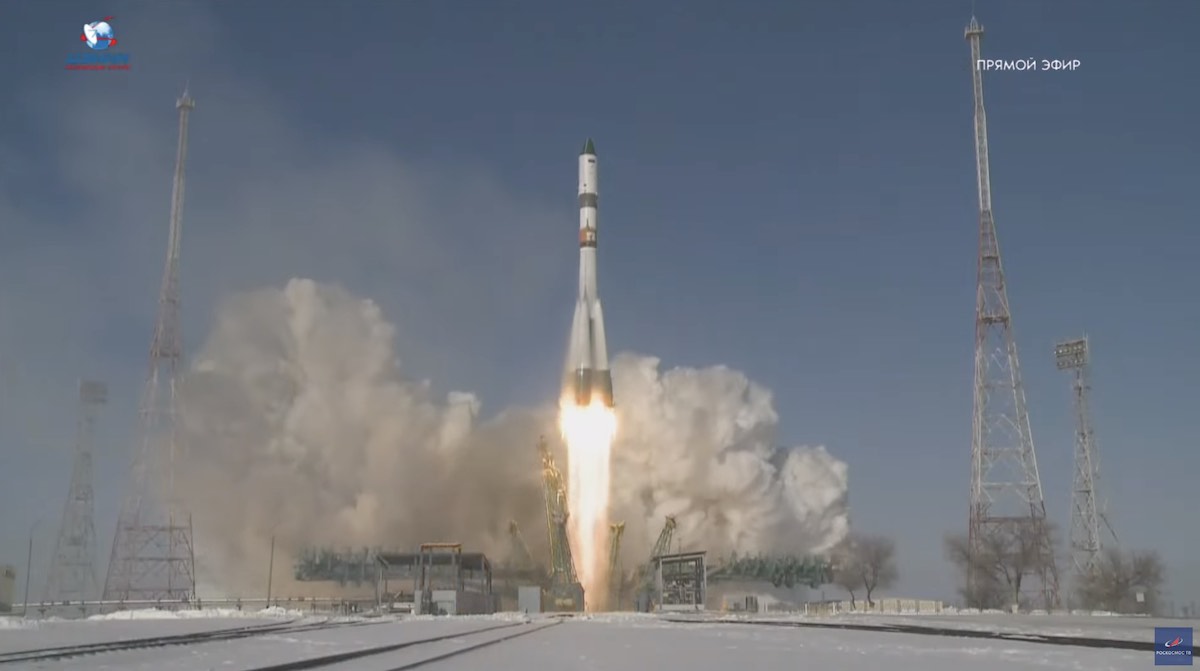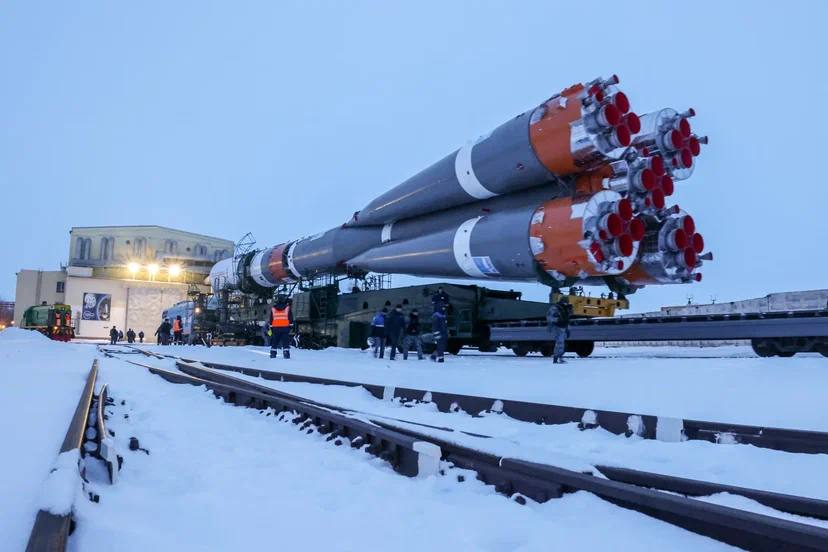Space News & Blog Articles
Russian Progress resupply ship launches on flight to space station
 A Soyuz-2.1a rocket lifts off Thursday with the Russian Progress MS-22 supply ship. Credit: Roscosmos
A Soyuz-2.1a rocket lifts off Thursday with the Russian Progress MS-22 supply ship. Credit: Roscosmos
A Russian Soyuz rocket blasted off Thursday from the Baikonur Cosmodrome in Kazakhstan, boosting a Progress resupply ship into orbit in pursuit of the International Space Station with more than 5,500 pounds of cargo, fuel, water, and air.
The Soyuz-2.1a rocket lifted off from the Site 31 launch complex at Baikonur at 1:15:36 a.m. EST (0615:36 GMT) Thursday to kick off a two-day flight to the space station. The three-stage Soyuz rocket released the Progress MS-22 supply ship into orbit about nine minutes into the mission, then the cargo freighter unfurled solar arrays and navigation antennas.
A series of orbit-raising engine firings will culminate in the ship’s automated docking to the rear port of the station’s Zvezda service module at 3:49 a.m. EST (0849 GMT) Saturday.
Russian cosmonauts on the station, part of the lab’s seven-person crew, will open hatches to begin unpacking cargo from the pressurized cabin of the Progress spacecraft.
Another cargo ship, Progress MS-20, undocked from the Zvezda module Feb. 6 (U.S. time) to head for a disposal burn and re-entry back into the atmosphere after an eight-month mission. The Progress MS-20 spacecraft was expected to largely burn up during re-entry over the remote Pacific Ocean.
The departure of the Progress MS-20 spacecraft cleared the way for the arrival of the new Progress supply ship Saturday.
 Rollout of the Soyuz rocket set to launch with the Progress MS-22 cargo freighter. Credit: Roscosmos
Rollout of the Soyuz rocket set to launch with the Progress MS-22 cargo freighter. Credit: Roscosmos
Meanwhile, Russian ground crews at Baikonur rolled the Soyuz rocket from its integration hangar to its launch pad Feb. 6. A hydraulic erector raised the rocket vertical at the Site 31 launch complex for final liftoff preparations, and gantry arms enclosed the Soyuz launcher to provide technicians with access to different parts of the vehicle.
Russian managers met a few hours before launch to approve loading of kerosene and liquid oxygen propellants into the Soyuz rocket. The gantry arms at the launch pad retracted away from the rocket in the final hour of the countdown, and ground crews at Baikonur inserted the launch key into a control panel about six minutes before liftoff.
Propellant tanks on the launcher pressurized beginning about two-and-a-half minutes prior to liftoff, and engines on the core stage and strap-on boosters ignited and ramped up to full power to propel the Soyuz off the pad with more than 900,000 pounds of thrust.
The Soyuz rocket headed northeast from Baikonur to line up with the flight path of the space station. The launcher’s four first stage boosters jettisoned two minutes into the flight, followed a minute later at T+plus 3 minutes and 3 seconds by jettison of the aerodynamic nose cone to reveal the Progress supply ship to the environment of space.
The Soyuz core stage, also known as the second stage, shut down and separated nearly five minutes after launch. A third stage RD-0110 engine ignited to finish the job of accelerating the Progress cargo freighter to orbital velocity, then deployed the supply ship almost nine minutes into the mission.
The Progress MS-22 mission is known as Progress 83P in the space station’s schedule of visiting vehicles. It’s the 83rd Russian Progress resupply mission to launch to the International Space Station.
Russia’s space agency said the Progress MS-22 cargo ship carries 5,586 pounds (2,534 kilograms) of supplies and fuel to the space station. Here’s a breakdown of the cargo manifest from Roscosmos, the Russian space agency:
• 2,985 pounds (1,354 kilograms) of dry cargo
• 1,587 pounds (720 kilograms) of liquid propellant to refuel the Zvezda service module
• 926 pounds (420 kilograms) of fresh water
• 88 pounds (40 kilograms) of air
The dry cargo includes food and clothing for the space station crew members, medical equipment, and experiments. The Russian supply ship will also reboost the orbital altitude of the station, and perform any required burns to steer the complex out of the path of space junk.
The launch Thursday was the first of up to 20 Soyuz rocket missions Russian plans in 2023, according to Roscosmos. The next Soyuz launch is set for Feb. 19 (U.S. time) from Baikonur with a Russian Soyuz crew ferry ship, which will take off and head for the space station without any cosmonauts aboard to replace a damaged Soyuz spacecraft docked at the complex.
The damaged Soyuz spacecraft leaked all of its coolant into space after an impact from a suspected tiny micrometeoroid in December, and Russian officials decided to launch the next Soyuz transport without a crew aboard. The new Soyuz will replace the damaged spacecraft, and will be used later this year for the return to Earth of two Russian cosmonauts and a U.S. astronaut.
This email address is being protected from spambots. You need JavaScript enabled to view it. the author.
Follow Stephen Clark on Twitter: @StephenClark1.
When you subscribe to the SpaceZE News Feed, we will send you an e-mail when there are new updates on the site so you wouldn't miss them.

